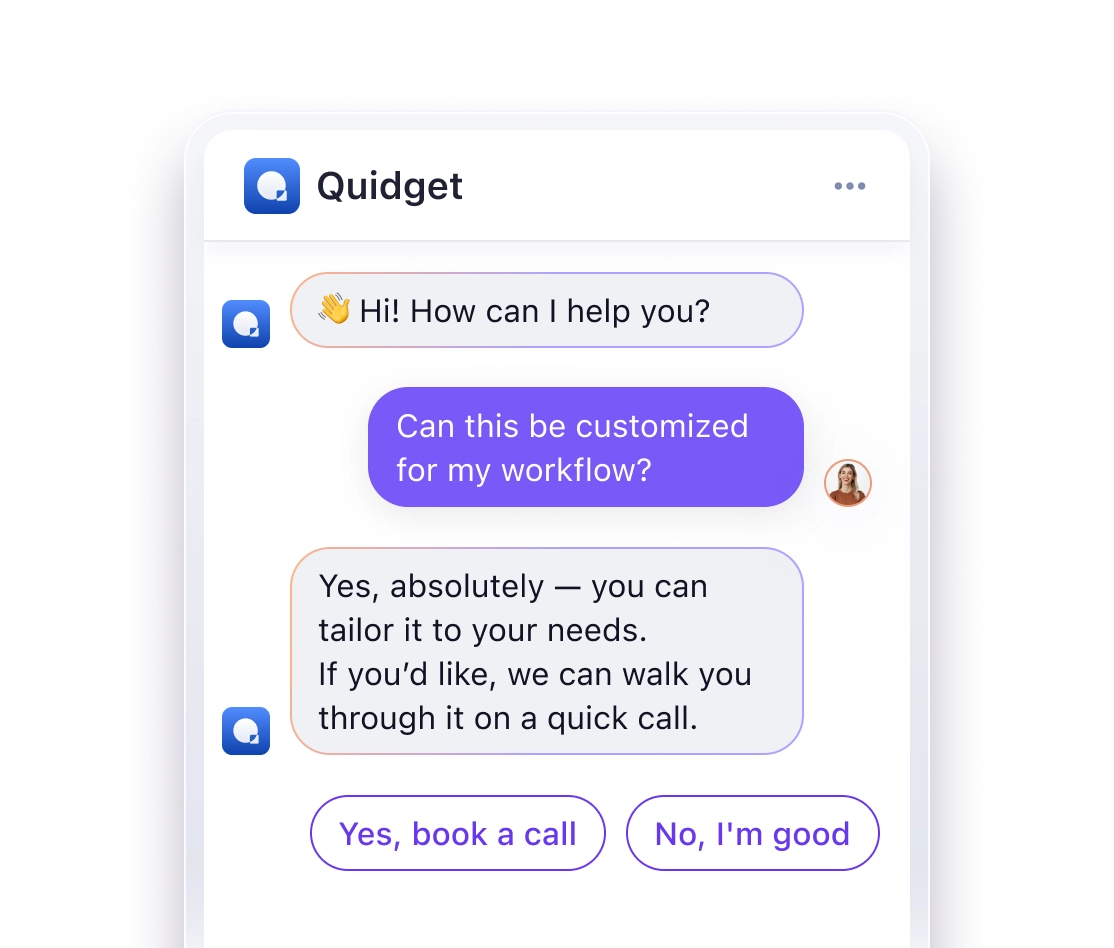Most AI chatbots promise to save time, but not all deliver. The right tool can cut support costs by up to 90% while improving student engagement.
In this article, you’ll find the top 10 AI chatbots for education platforms in 2025, including tools like Quidget, which handles 80% of student questions instantly, and Duolingo, which now uses GPT-4 for personalized learning.
– Learn which chatbots simplify onboarding, automate admin tasks, and support multiple languages.
– See how universities like Georgia Tech reduced workloads and improved student outcomes with AI.
– Compare pricing, features, and use cases to pick the best option for your needs.
Here’s what you need to know to make the right choice.
From Concept to Chatbot: Enhancing Education with Custom AI Tools
1. Quidget – AI Chatbot for Online Education
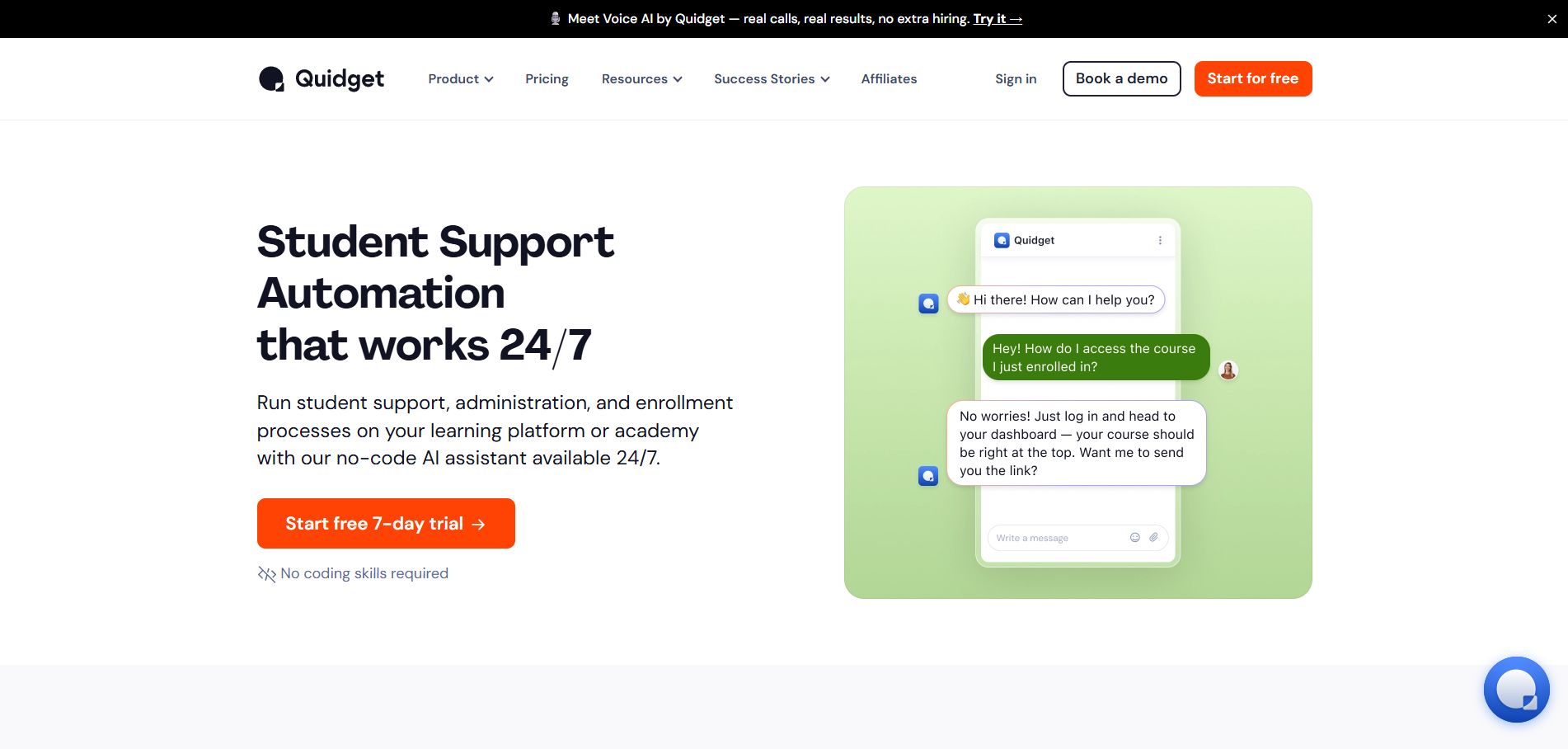 Quidget is an AI chatbot tailored for educational institutions, making student interactions easier and more efficient. Developed by SupportYourApp, a company with over 14 years of experience in support, Quidget provides automation designed to handle the demands of high-volume education environments. It can instantly address up to 80% of student queries while reducing support costs by as much as 90%.
Quidget is an AI chatbot tailored for educational institutions, making student interactions easier and more efficient. Developed by SupportYourApp, a company with over 14 years of experience in support, Quidget provides automation designed to handle the demands of high-volume education environments. It can instantly address up to 80% of student queries while reducing support costs by as much as 90%.
Student Onboarding and Support
Quidget goes beyond answering questions – it simplifies the entire student journey. From enrollment to ongoing support, it automates key processes like course registration, platform navigation, and administrative tasks. During busy times, when support teams are overwhelmed, Quidget ensures response times stay consistent, even under heavy workloads. For more intricate issues, the chatbot seamlessly transitions conversations to human agents, providing full context so students don’t have to repeat themselves.
Multilingual Support
One standout feature is Quidget’s ability to communicate in over 45 languages. It automatically detects and switches to the student’s preferred language, offering a personalized experience without any additional setup. This is especially helpful for international students seeking information about courses, deadlines, or campus resources.
Integration with Education Platforms
Quidget integrates smoothly with popular platforms and communication tools, ensuring support is available wherever students need it. Whether it’s email, web chat, WhatsApp, or Slack, Quidget delivers consistent assistance. It also connects with tools like Zendesk and Calendly, enhancing its functionality for administrative tasks.
Automating Administrative Workflows
Quidget doesn’t just answer questions – it handles complex tasks, too. For example, it can collect student details and schedule advising sessions through Calendly. By automating these processes, staff can focus on addressing more nuanced student needs. With pricing starting at $16 per month for the Starter plan, Quidget offers scalable solutions to fit the needs of institutions of all sizes.
The no-code setup means Quidget is ready to tackle student interactions right from the start.
2. LearnWorlds – AI Course Creation and Student Support

LearnWorlds blends course management with responsive student support, making it a go-to platform for educators and enterprises alike. With a 4.7/5 rating on G2 and Software Advice based on 189 reviews, it offers tools that cater to course creators, educators, and businesses. The platform is SCORM-compliant and supports interactive course authoring, detailed analytics, multilingual content, and mobile access. Plus, it handles unlimited learners, making it a strong choice for scaling educational programs. These features create an environment where both course creation and student engagement thrive.
Student Onboarding and Support
LearnWorlds simplifies the onboarding process for new students. From account setup to accessing courses and tracking progress, everything is managed through a centralized dashboard. Educators can also personalize their platform’s look and feel, including the course player interface, to create a welcoming experience. Features like welcome messages and guided tours make it easier for learners to navigate and get started.
Integration with LMS and Education Tools
The platform integrates seamlessly with tools for marketing, email, analytics, HR, and CRM, including Zapier, Zoom, MailChimp, HubSpot, and FreshDesk. Payment processing is supported through PayPal, Stripe, and Shopify. It also adheres to industry standards like SCORM, xAPI, and AICC, with API access for custom workflows. These integrations make it a flexible option for existing educational infrastructures. Reviewers frequently highlight the platform’s responsive support team, which is especially valuable as 98% of large organizations are now embracing LMS platforms. This connectivity helps streamline administrative tasks and enhances overall efficiency.
Automation of Administrative Tasks
LearnWorlds reduces the burden of administrative work with its User Automations feature. This tool can automatically grade open-text assignments and deliver additional learning resources to students who may need extra help. Its Reports Center offers insights into user progress, registrations, engagement levels, and learner demographics, with options to export data for more in-depth analysis.
One user reported a 50% boost in team efficiency thanks to these features.
3. Crowdy – AI Chatbot for Student Engagement
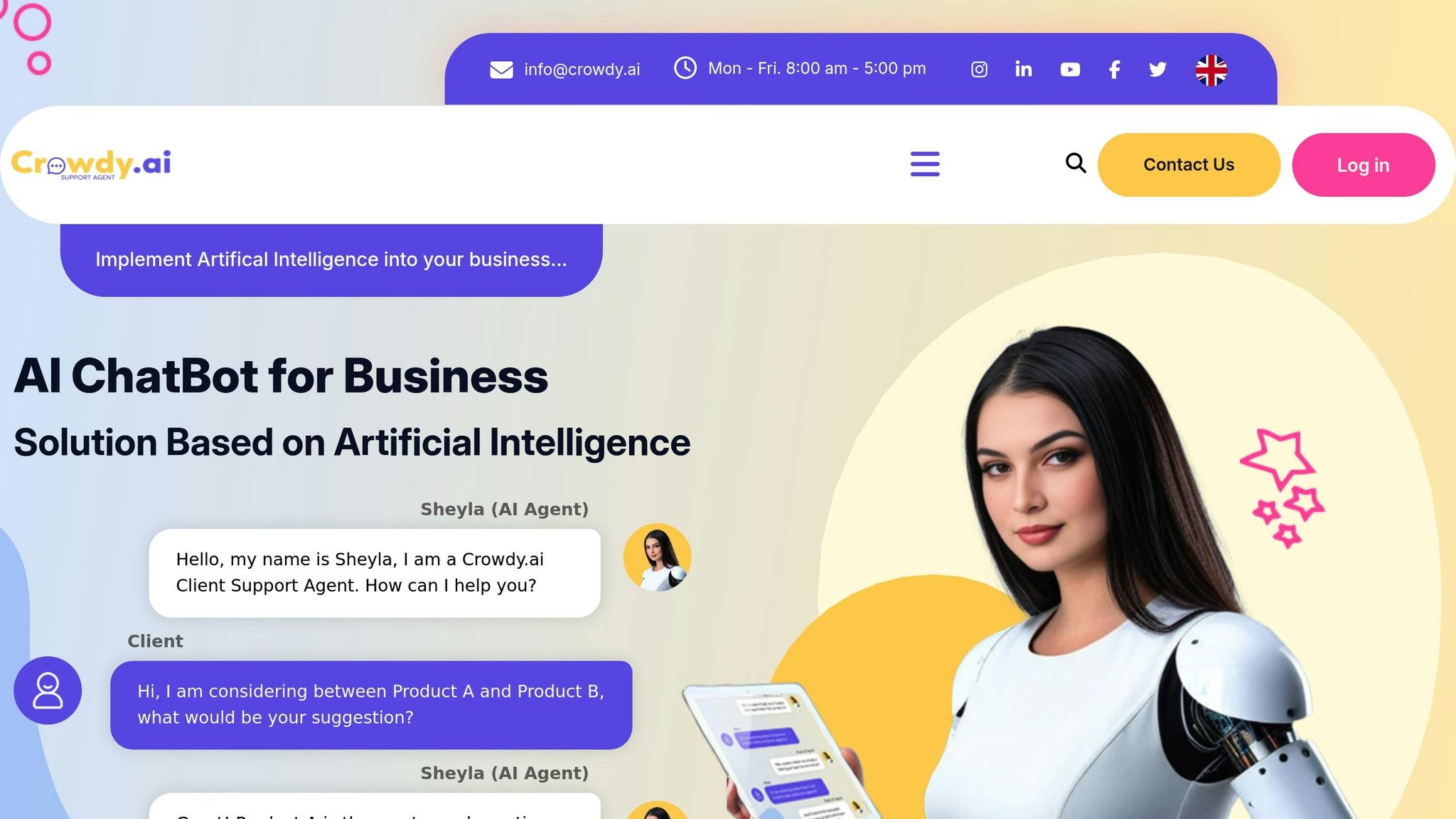
Crowdy is designed to keep students engaged by handling routine tasks, providing instant answers, and sending personalized course suggestions and study reminders. Whether students need details about courses, class schedules, or exam dates, Crowdy offers immediate responses. It’s available 24/7 and supports over 30 languages, making it a valuable tool for creating an inclusive learning environment for a diverse student population.
These features help streamline onboarding and simplify administrative processes.
Student Onboarding and Support
Beyond engagement, Crowdy makes onboarding easier for students. It sends timely reminders and guides new users through steps like registration, choosing courses, and navigating the platform.
Multilingual Support
Crowdy’s ability to operate in over 30 languages is a game-changer for international students. The chatbot automatically detects a user’s preferred language and adjusts accordingly, making interactions smoother and more personalized while breaking language barriers.
A statement from Crowdy highlights this:
"At Crowdy.ai, we have built a powerful AI ChatBot that transforms customer interactions. Fully AI-driven, it improves service efficiency and enables smooth, multilingual communication for a more personalized experience."
Integration with Learning Tools
Crowdy seamlessly integrates with existing educational systems like CRMs, social media platforms, and messaging apps. This integration centralizes student data and supports interactive features like online sessions, quizzes, and tests. Its workflow automation tools also help institutions manage student interactions more effectively.
Simplifying Administrative Work
Crowdy also takes care of repetitive administrative tasks such as course registrations, schedule inquiries, and other basic requests. By automating these processes, the chatbot reduces the workload on staff, creating a more organized and efficient learning environment.
"Crowdy’s chatbot is ideal for educational institutions, automating key processes, improving communication and increasing efficiency."
4. Botpress – AI Chatbot for Higher Education
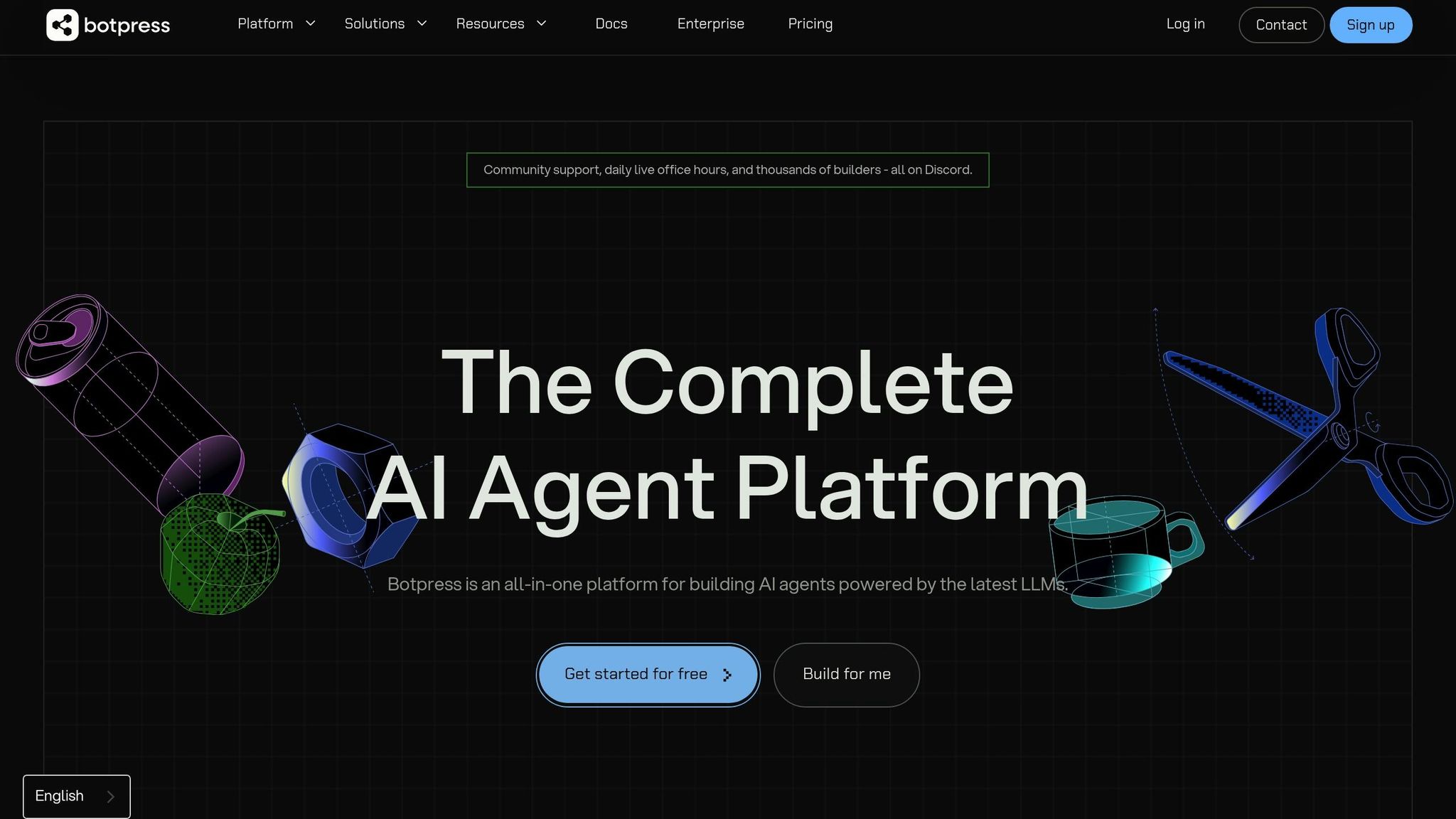
Botpress is an AI platform designed for developers to create custom conversational tools tailored for higher education. Using code and webhooks, it supports multi-step workflows and connects various communication channels with CRMs, data sources, and human agents. This flexibility allows institutions to address the needs of diverse student populations and streamline complex administrative tasks. The platform’s adaptability ensures personalized support for both student onboarding and academic interactions.
Student Onboarding and Support
Botpress enhances the student orientation experience by offering welcome tours, guidance on campus culture, and managing event RSVPs. Beyond orientation, it aids academics by providing lecture summaries, personalized learning plans, academic advising, assignment reminders, and even tutoring suggestions.
Integration with LMS and Other Tools
The platform seamlessly integrates with Learning Management Systems (LMS) and other tools commonly used in higher education. By connecting with systems like SIS and LMS, Botpress delivers real-time access to course schedules, grades, and other essential details, creating a more tailored experience for students.
Streamlining Administrative Tasks
Botpress automates a variety of routine administrative processes, including answering FAQs, assisting with applications, managing course registrations, and handling inquiries related to libraries, IT, and documents. For example, Maryville University’s AI assistant "Max" operates 24/7, addressing over 6,000 student questions each month and resolving 97% of them without human help. Additionally, AI-driven teaching assistants and automation tools can help save educators up to 30% of their time.
5. Duolingo – AI-Powered Language Learning Assistant
Duolingo has come a long way from being a simple language-learning app. Today, it’s an AI-driven platform connecting with over 110 million active users monthly. Its daily active user base grew by 51% year-over-year in Q4 2024, surpassing 40 million users. This impressive growth is largely due to its focus on AI-powered personalization and interactive experiences.
The premium subscription tier, Duolingo Max, leverages GPT-4 technology to introduce features like "Explain My Answer" and "Roleplay". With courses in over 40 languages, Duolingo continues to expand its reach.
Personalized Learning and Interactive Tools
Duolingo’s AI tailors learning paths to match each student’s proficiency and pace. The "Explain My Answer" tool offers detailed feedback to help users understand their mistakes. In September 2024, the platform introduced the "Video Call" feature for Max subscribers, enabling conversations with Lily, one of Duolingo’s popular characters. It also launched "Adventures", a game that immerses learners in real-world scenarios like navigating a passport check or ordering coffee. These features combine fun with practical learning, enhancing the overall experience.
"Our mission is to develop the best education in the world and make it universally available. We believe the best way to do that is by continuously pushing the boundaries of technology." – Luis von Ahn, co-founder and CEO of Duolingo
Real-World Language Practice
Duolingo’s "Roleplay" feature enables learners to engage in realistic conversations with AI-powered characters across various languages. The AI adjusts the complexity and provides feedback, creating a tailored learning experience. This low-pressure environment encourages practice, and over 90% of users who utilized AI tools for a month felt confident applying their language skills in real-life situations.
Beyond conversations, Duolingo integrates reading, writing, and speaking into its lessons. Bite-sized sessions allow students to study multiple languages while the AI adapts the content based on their progress and performance.
Tools for Educators and Institutions
Duolingo for Schools offers features like online classrooms, assignment scheduling, and progress tracking. The platform also provides the Duolingo English Test (DET), accepted by over 5,500 institutions, including 97 of the top 100 U.S. universities, for placement and proficiency testing.
In April 2025, Duolingo doubled its course offerings by launching 148 new AI-generated language courses, addressing the growing demand from institutions.
Simplifying Administrative Work
AI has transformed Duolingo’s content creation process, increasing its capacity tenfold in the past two years. It also automates tasks like tracking progress, generating reports, and recommending review sessions.
"To teach well, we need to create a massive amount of content, and doing this manually doesn’t scale." – Luis von Ahn
Educators using Duolingo for Schools gain access to detailed analytics on student engagement and completion rates. The AI not only adjusts lesson difficulty and provides instant feedback but also creates customized practice exercises. By reducing the administrative workload, it allows teachers to focus on delivering a more personalized learning experience – an efficiency that mirrors other AI-driven educational tools.
6. Paradiso – Virtual Tutor AI for EdTech
Paradiso Solutions has developed an AI-powered tutor that tailors learning experiences by analyzing student interactions. This system creates personalized learning paths, delivers instant feedback, and provides targeted practice sessions to address individual needs. It aims to tackle key challenges in digital education by combining tailored instruction with efficient administrative tools.
"Paradiso AI platform enhances online education by offering dynamic content creation, real-time assistance, adaptive assessments, and solutions for breaking language barriers, all designed to improve engagement and accessibility." – Paradiso Solutions
By focusing on personalization, Paradiso’s AI tutor simplifies both learning and student support, starting from enrollment.
Student Onboarding and Support
With 24/7 availability, Paradiso’s AI tutor assists students throughout their educational journey. Using natural language processing, it interprets student queries and adapts educational content to suit individual learning styles and needs. Schools using Paradiso LMS have seen a 40% increase in enrollment and better outcomes for at-risk students.
Integration with LMS and Educational Tools
Paradiso LMS integrates seamlessly with a wide array of educational tools. It connects with over 100 applications, including Student Information Systems (SIS), CRM platforms, and video conferencing tools like Zoom and Microsoft Teams. The platform supports key content standards like SCORM, Tin Can (xAPI), and AICC. Additionally, it offers pre-built integrations for tools like event management systems, membership forums, webinar platforms, and eCommerce software. Features like APIs and single sign-on ensure secure, tailored connections, allowing schools to keep using their existing tools.
Multilingual Capabilities
Paradiso’s LMS supports over 120 languages, automatically translating course content, titles, and descriptions while allowing manual edits when needed. This functionality ensures accessibility for diverse student groups and enables users to switch languages during sessions, making complex topics easier for non-native speakers to grasp.
Automation of Administrative Tasks
By automating administrative workflows, Paradiso’s AI reduces manual tasks by 60%, which has led to a 40% drop in work-related stress for staff. The system tracks student progress, generates detailed reports, and schedules review sessions based on individual learning patterns. These efficiencies have contributed to a 75% increase in project completion rates.
7. Preply – AI Chatbot for Tutoring and Scheduling
Preply is transforming how tutors and students interact by offering tailored exercises and fostering conversational practice, all powered by AI.
What sets Preply apart is its ability to go beyond basic automation. The platform evaluates student performance and learning habits to pinpoint challenges, then crafts custom lesson plans and summaries to address those areas. The results speak for themselves: 90% of Preply’s business students report better language skills, and 89% say it has positively impacted their work performance.
"We began working on AI at Preply before we had a dedicated team – AI was an area of exploration within our core product team. Initially, we were at a crossroads with many questions ‘Which provider should we use? Will it be fast enough? How can we ensure high-quality AI-generated results?’ and so on. However, for me as a product designer, the main challenge and question was explaining the full power of AI for learning without making the interface overly complex." – Vlad Kyshkan, Product Designer
This thoughtful integration of AI lays a strong foundation for effective student onboarding and continuous support.
Student Onboarding and Support
Preply’s AI chatbot supports students at every stage of their learning journey. Available 24/7, it offers multilingual assistance and addresses questions in real time. Using natural language processing, the system can track language proficiency, and students in one-on-one sessions have seen a 35% improvement in their language scores.
Multilingual Capabilities
With users spanning the globe, Preply ensures accessibility by offering multilingual support. This feature makes it easier for learners from various linguistic backgrounds to connect and communicate effectively.
Integration with LMS and Educational Tools
Preply doesn’t just focus on tutoring; it also integrates seamlessly with learning management systems (LMS) and other educational tools. The platform includes a co-pilot tool designed for tutors, automating repetitive tasks like content creation while keeping the focus on human interaction. To enhance self-learning, Preply introduced the "TalkNow" feature, powered by ChatGPT, for dynamic conversational practice.
"AI will accelerate education. I think that’s something to celebrate. We put control in the hands of the tutors and the students. That’s our starting point and overall approach." – Josh Crossick, Chief Product Officer of Preply
Automating Administrative Tasks
Preply also simplifies administrative tasks, making life easier for tutors. Its AI automates lesson summaries, tracks student progress, and provides personalized study recommendations. The team managed to build the core functionality in just a week, showcasing their streamlined design approach. To further support educators, Preply has hosted webinars on using AI to handle routine tasks, allowing tutors to dedicate more time to creative teaching.
sbb-itb-58cc2bf
8. Ada – Multilingual AI Chatbot for Education
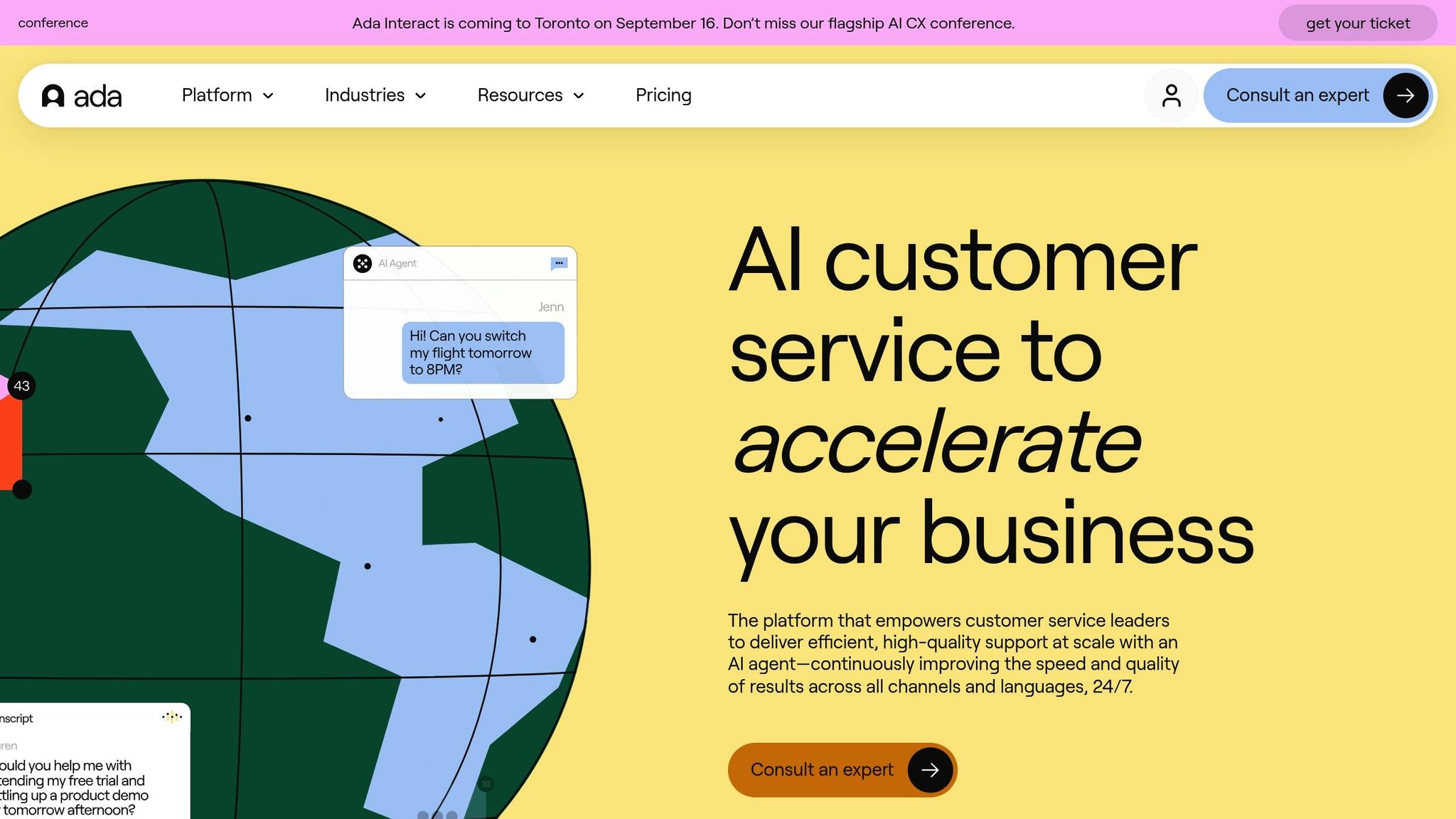
Ada stands out as a multilingual AI chatbot designed to break down language barriers in education. Supporting over 50 languages, it opens doors for students from diverse linguistic backgrounds, making educational resources accessible on a global scale.
By combining broad language support with smart automation, Ada helps educational institutions provide personalized assistance. Whether it’s answering questions about courses, schedules, or campus services, Ada keeps students engaged while lightening the administrative load.
"Ada allows brands to take every opportunity to ensure their engagement with customers goes beyond language or time zone." – David Hariri, Co-founder @ Ada
This combination of features simplifies student onboarding and reduces administrative challenges. Let’s dive into how Ada’s multilingual capabilities empower both students and institutions.
Multilingual Capabilities
Ada’s language support is extensive, covering global languages like Spanish, French, and Mandarin, as well as regional ones such as Afrikaans, Khmer, and Zulu. It offers two translation options: automatic translation through Google Translate or custom translations created by educators for more accurate communication.
Students can switch languages in several ways – via autodetection, selecting a preferred language, or adjusting chat settings. While English is the default, the chatbot can handle queries in any supported language. For smooth operations, Ada advises institutions to enable only the languages their support staff can fluently manage, ensuring students aren’t transferred to agents unable to assist in their preferred language.
These multilingual tools not only enhance communication but also improve the onboarding process and ongoing support, as detailed below.
Student Onboarding and Support
Ada streamlines common student inquiries, handling tasks like enrollment, course registration, and policy questions. This automation frees up staff to focus on more complex issues. With 24/7 availability, students can access help anytime, no matter their time zone or schedule. ProProfs Chat rated Ada 4.6 out of 5 stars for its multilingual support and round-the-clock functionality.
Automation of Administrative Tasks
Ada also takes on repetitive administrative tasks such as processing enrollments, managing registrations, and sharing program details, reducing the workload for staff.
Real-world examples underline the effectiveness of such technology. Georgia State University, for instance, implemented a chatbot named Pounce to combat summer melt, achieving a 22% drop in students failing to enroll and earning a 94% recommendation rate among students. Similarly, the University of Murcia’s chatbot, Lola, resolved 90% of student queries during admissions and enrollment. These success stories show how AI chatbots can streamline administrative processes while maintaining high levels of student satisfaction across languages and time zones.
Ada exemplifies how AI chatbots are reshaping online education, balancing personalized student engagement with administrative efficiency.
9. Chatfuel – No-Code Chatbot for LMS Integration
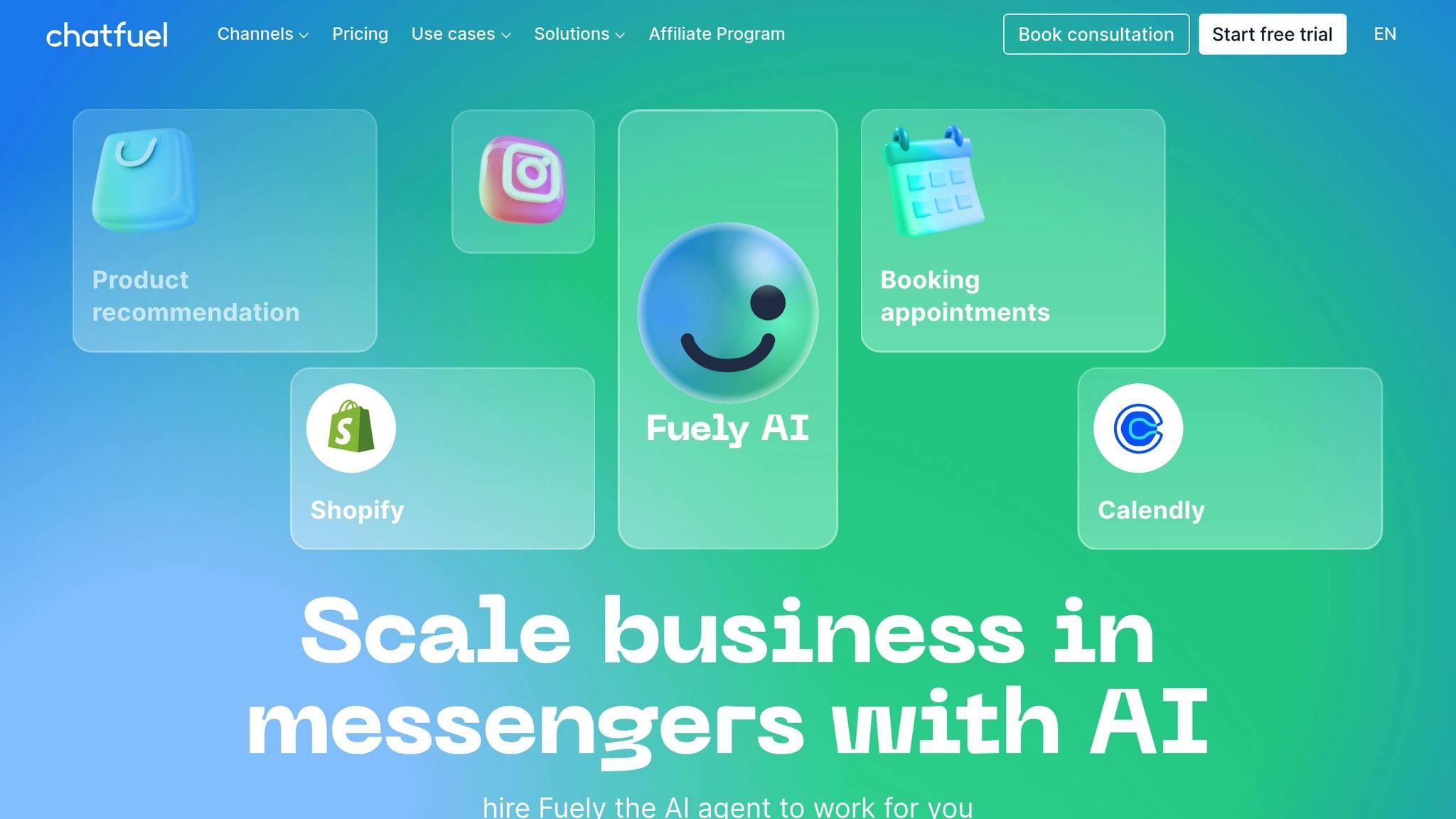
As online education continues to grow, Chatfuel steps in as a no-code chatbot platform tailored for education. With its drag-and-drop interface, it’s designed for quick setup and works seamlessly with popular messaging platforms like Facebook Messenger, Instagram, WhatsApp, and websites. This makes it easy for educators to deploy chatbots without technical expertise.
Chatfuel empowers institutions to create chatbots that handle routine tasks like answering student questions, sharing course details, and managing administrative processes. Its automation features are particularly helpful for streamlining communication in educational settings.
Integration with LMS and Education Tools
Chatfuel connects directly with Learning Management Systems (LMS), simplifying communication between students and educators. For instance, it integrates with platforms like Academy LMS without requiring any coding adjustments. Through its API, Chatfuel can sync with various educational systems to share student data, course schedules, and assignment details. By automating up to 80% of routine inquiries, Chatfuel significantly reduces response times and enhances the overall experience for students. This integration is a practical solution for institutions looking to simplify their tech stack while ensuring efficient communication.
Automating Administrative Work
Beyond integration, Chatfuel is a powerful tool for automating essential administrative tasks. It can handle student inquiries, share study materials, and send reminders for assignments. The chatbot also supports course enrollment and registration by guiding students through each step. A great example is Ultima.School, which used a Chatfuel bot on WhatsApp to cut its customer acquisition costs in half while maintaining the same conversion rates as its sales team. By automating these processes, educators and administrators can shift their focus toward enhancing curriculum and offering personalized support to students.
Multilingual Features
For institutions with diverse student populations, Chatfuel’s multilingual capabilities are a standout feature. Educators can design separate chatbot flows for different languages. The platform can detect a user’s default language through Facebook’s locale settings or let users select their preferred language via buttons or quick replies. Its Localization feature even allows for persistent menus in multiple languages, ensuring a smooth user experience. For example, Go Correct, an English learning platform, uses Chatfuel to help over 2,000 users improve their English skills. Studies show that 75% of online users across ten countries prefer interacting in their native language, highlighting the importance of this feature. Additionally, Chatfuel can integrate with tools like Dialogflow and Janis.AI to handle various language styles effectively. These multilingual abilities make Chatfuel a practical choice for reducing workload while keeping students engaged.
10. Intercom – AI Chatbot for Student Support and Communication
Intercom serves as a central hub for student support, marketing, and sales in educational settings. Its AI chatbot, Fin, can instantly handle 50% of support queries, while the Copilot feature helps human agents manage 31% more conversations each day.
Streamlining Student Onboarding and Support
Intercom enhances student onboarding with its customizable messenger widget, which integrates seamlessly into websites and platforms. This feature consolidates messages from email, social media, and in-app channels, making communication easy to track and manage.
Its built-in knowledge base allows students to quickly find answers without leaving the chat interface. Additionally, custom bots streamline the process by pre-qualifying questions and directing them to the appropriate departments, cutting down response times significantly.
Breaking Language Barriers with Multilingual Support
For schools and universities with diverse student populations, Intercom offers multilingual chat support. This feature is especially valuable, as 69% of users prefer chatbots that provide instant support in multiple languages.
Integration with Learning Tools and LMS Platforms
Intercom connects with leading LMS platforms and educational tools to create a seamless learning and support experience. For example, in July 2025, WorkRamp added the Intercom chat bubble to their Academy, enabling users to reach support teams without leaving the platform. Similarly, Docebo used Intercom to automate tasks like user profile creation and training program enrollments based on support interactions. These integrations have shown to increase user engagement significantly.
Automating Administrative Work
Intercom’s automation features take on routine administrative tasks, such as answering FAQs, sharing course details, and managing enrollment inquiries. It also sends outbound messages like announcements, deadline reminders, and special offers, ensuring students stay informed.
"Combining automation and human support, blending those two together, allows our teammates to do what they do best – be creative, be empathetic, and do the things that only humans can do, and that’s to find unique solutions to difficult problems." – Sam Miller, Customer Support Operations Manager, Dental Intelligence
Pricing Options
Intercom’s pricing starts with the Essential Plan at $39 per user per month, covering basic chat and messaging features. The Advanced Plan, at $99 per user per month, includes added customization and reporting capabilities. For $139 per user per month, the Expert Plan offers comprehensive support agreements.
Feature Comparison Table
Here’s a breakdown of top AI chatbots for online education in 2025, comparing their features, pricing, and capabilities.
| Chatbot | Best For | Key Features | Multilingual Support | No-Code Setup | Starting Price | Free Trial |
|---|---|---|---|---|---|---|
| Quidget | Small to medium educational institutions | AI agent builder, 24/7 support, live chat handoff, supports 45+ languages | Yes | Yes | $16/month | 7 days |
| LearnWorlds | Course creators and online schools | AI course creation, student engagement, progress tracking | Limited | Yes | Custom pricing | Available |
| Crowdy | Student engagement and community building | Social learning features, peer interaction, gamification | Yes | Yes | Custom pricing | Available |
| Botpress | Higher education institutions | Visual builder, advanced integrations, custom workflows | Yes | Yes | $0/month (pay-as-you-go) | Free tier available |
| Duolingo | Language learning platforms | AI-powered tutoring, adaptive learning, progress analytics | Yes | No | Subscription-based | Limited free version |
| Paradiso | Corporate training and EdTech | Virtual tutoring, LMS integration, performance analytics | Yes | Partial | Custom pricing | Available |
| Preply | Tutoring and scheduling platforms | AI scheduling, tutor matching, payment processing | Yes | Yes | Custom pricing | Available |
| Ada | Large educational organizations | Advanced AI, enterprise security, detailed analytics | Yes | Yes | $5,000/month | Custom demo |
| Chatfuel | LMS integration and automation | Facebook Messenger integration, broadcast messaging | Yes | Yes | $1,019.99/month | 7 days |
| Intercom | Student support and communication | Comprehensive support suite, advanced automation | Yes | Partial | $29/month per user | 14 days |
Key Takeaways
– Pricing: AI chatbot pricing varies widely, starting around $30/month for smaller institutions and scaling to $10,000+ for enterprise needs. Small to medium-sized schools typically spend $30–$150/month, while mid-market solutions range between $800–$1,500/month. Enterprise plans often exceed $3,000/month.
– No-Code Options: For educators without technical expertise, platforms like Quidget, Chatfuel, and Botpress offer straightforward no-code setups, making chatbot deployment accessible.
– Multilingual Support: Many platforms support multiple languages. Notable options include Ada, Chatfuel, and Botpress, with Quidget covering over 45 languages.
– Free Trials: Most platforms provide a trial period to test features before committing. Botpress offers a pay-as-you-go model starting at $0/month, with a $5 AI credit included. Quidget provides a 7-day trial with no credit card required, and Intercom offers 14 days to explore its tools.
When choosing a virtual tutor AI, match the platform to your goals. For example, Quidget is ideal for student onboarding and support, while Duolingo specializes in language learning.
Conclusion
AI chatbots are stepping in to tackle some of the biggest challenges in education. With 42% of students struggling to stay motivated in online courses and 64% of faculty experiencing burnout, these tools offer much-needed support by automating tasks and providing 24/7 assistance.
By handling routine tasks and answering common questions, chatbots allow educators to dedicate more time to meaningful teaching and improving learning experiences.
However, successful implementation requires thoughtful planning. Schools and universities must address digital inequality and ethical concerns while ensuring educators receive regular training to effectively use these tools. The goal isn’t to replace the human element but to complement it – encouraging critical thinking and problem-solving while maintaining the personal connections that are vital in education. Feedback from students highlights the varied experiences with AI:
Andrea, 17, shared:
"A focus on transparency is needed as more and more corporations start including AI in their products"
Rose, 18, expressed:
"Programs like ChatGPT lack the ability to form emotional connections with readers. We cannot rob writing of human emotion"
Audrey, 17, reflected:
"As technology rapidly improves, we learn to embrace it and ChatGPT should be no exception"
Integrating AI chatbots can help address these challenges while simplifying support processes. Each solution comes with its own strengths, so it’s important to choose one that aligns with your specific needs – whether that’s student onboarding, language support, LMS integration, or general assistance. For small to medium educational institutions, Quidget stands out with its no-code setup, support for 45+ languages, and an affordable starting price of $16/month.
Ready to see how AI chatbots can transform your educational platform? Try Quidget free for 7 days – no credit card required.
FAQs
How can AI chatbots like Quidget help schools engage students and save on support costs?
AI chatbots like Quidget are transforming the way students learn by providing instant, tailored responses to their questions. Acting as virtual tutors, these bots make learning more interactive, guiding students through coursework and clarifying common doubts on the spot.
For schools, the benefits go beyond just enhancing the learning experience. Chatbots help cut costs by automating repetitive tasks such as answering FAQs, managing schedules, and assisting with onboarding. This not only lightens the load for staff but also allows them to concentrate on more complex or impactful responsibilities, all while ensuring students receive quick and reliable support.
What should I look for in an AI chatbot for an online education platform?
When selecting an AI chatbot for your online education platform, it’s important to prioritize features that address both technical requirements and student needs. Here are the key considerations to keep in mind:
– Integration: The chatbot should work effortlessly with your existing systems, like your LMS (Learning Management System) and SIS (Student Information System).
– Ease of Use: Opt for a platform that doesn’t require coding knowledge, making it straightforward to set up and manage.
– Language Support: Multilingual functionality is a must if your student base includes speakers of different languages.
– Personalization: Choose a chatbot that can adjust to individual learning styles and offer tailored assistance.
– Security: Protecting student data is non-negotiable. Verify the chatbot complies with privacy standards and safeguards sensitive information.
Additionally, think about scalability. As your platform expands, the chatbot should be able to grow with it, continuing to enhance learning experiences while reducing the burden of administrative tasks.
How do AI chatbots support multiple languages, and why does this matter for international students?
AI chatbots can engage with users in various languages, including Mandarin, Spanish, and French. This capability removes language barriers, making it simpler for international students to get the assistance they need.
With multilingual support, chatbots provide quick and clear access to information, helping students avoid misunderstandings and feel more at ease with their educational platform. This feature proves especially helpful when handling tasks like onboarding, checking class schedules, or finding academic resources.



